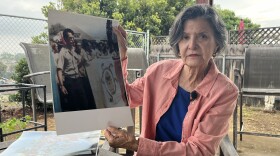Katie Roiphe's preoccupation with death goes back to her childhood, when she contracted virulent pneumonia at the age of 12. She was sick for a year and thought she was going to die.
Her terror of death was reignited many years later when her father died. It was then that Riophe found herself turning to great minds to see how they confronted mortality.
She initially told herself that she wanted to "understand it better," she tells NPR's Melissa Block, but she soon realized that was a lie. "I was actually trying to see it," she explains. "It sounds really simple, but it's actually a very difficult thing to do. So that was my goal, to sort of focus in really closely on the final days of these writers and thinkers, and just look."
In The Violet Hour, Roiphe describes the last days of Sigmund Freud, James Salter, Maurice Sendak, Susan Sontag, John Updike and Dylan Thomas. She talks with Block about how these writers and thinkers accepted, or railed against, their fate.
Interview Highlights
On John Updike, who wrote poems in the hospital after being diagnosed with lung cancer
It was amazing. He had very little time — just weeks before he was dead. I actually went up and looked at the manuscripts and you can see in his handwriting how arduous it was. At that last moment, when most people would just be watching television or railing against the universe, that was what he did and I found it very moving. ...
The poems have a sort of quality of reporting — that he's bringing news. And he talks about writing as turning pain into honey, which I find a really beautiful way to think about what writers do: taking this incredibly awful — maybe the most awful thing that can happen to you — and turning it into honey just with words.
On Susan Sontag, who endured brutal treatments for cancer
She had written so eloquently about the importance of not turning illness into a metaphor — of not embellishing and fantasizing and being really realistic and rational when it comes to your own illness — and she was unable to do that ironically in her own life. ...
She thought to herself she would be the exception even to the rule of mortality. That somehow, as she had with her earlier cancers famously, she was going to defeat death in some way. And even though the odds were against her — she was 71-years-old getting a bone marrow transplant — even in those situations, she felt this time she wouldn't die.
At the one hand, it's the opposite of a good death, it's almost the anatomy of how you don't want to die. On the other hand, I did see something kind of heroic in the power and force of her will.
On how mortality was a constant companion for writer and illustrator Maurice Sendak
He was certainly preoccupied with death for his entire life, and one of the things that fascinated me about him is the way, in his art and famous children's books, he worked on this problem year after year. Like when his parents died, or when his brother died, he just kept working on this problem and worked it through in drawing after drawing and draft after draft. And he sort of came out freeing himself to a certain extent from this obsession. He was very depressed at certain points of his life and he used his art as a way of countering that. It was a sort of medication for that almost.
On Sendak owning John Keats' death mask
It's really very beautiful. When I saw it — he has it in a guest room with a blue bedspread — there are kind of stuffed animals on the bed. It's a very bizarre scene and very Sendak, and I thought to myself, "Who would ever want to own Keats's death mask?"
And then I looked at it and I realized I knew exactly why you'd want to own Keats' desk mask: Because in a way what I was doing in this book was writing death masks. That urge to preserve the moment, and Annie Leibovitz did it with her famous photographs of Sontag, and Sendak himself drew the people he loved: his partner of many, many years after he died, and his family members right before they died.
There's something about capturing that moment in art that I actually do completely understand — both the reason you'd make Keats' death mask and the reason you'd want to own it.
On her idea of what a "good" death would be
I feel like the thing that mostly happened with this book is I came away marginally less afraid, which sounds like not that a big deal. But given my panic about death at various points in my life, [this] was liberating to me. In terms of a good death, I did feel that this prolonged medical struggle of a Susan Sontag where you're chasing after any possibility of medical salvation seemed like not a good idea, and the way of working your way into accepting what's happening the way Sendak did and the way Updike did seems preferable to me.
But one doesn't always have control, and that was one of the things I really realized in writing about these deaths.
Copyright 2024 NPR





